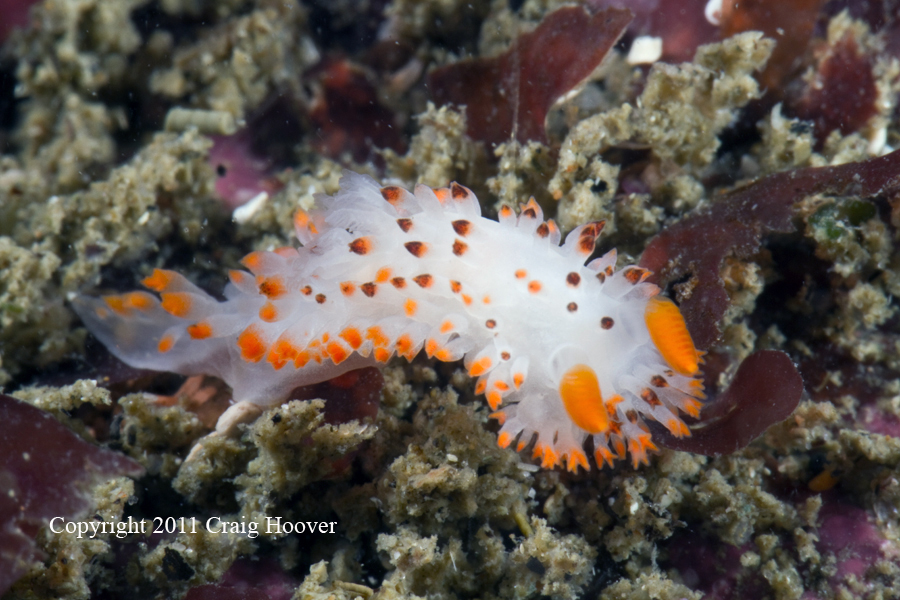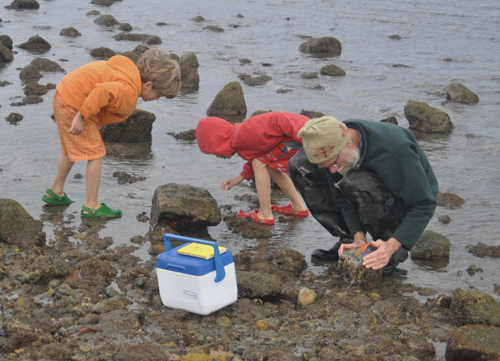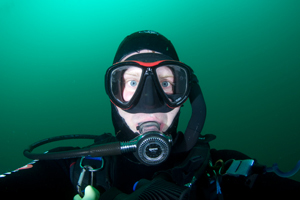 |
Crimora coneja
Image courtesy of Craig HooverSpooner Cove in Montana del Oro state park
Canon 7D in an Aquatica housing. The lenses used were a Canon 100 mm and a macromate 2X wet diopter.
Lighting was from Two Sea & Sea YS 110a strobes and one Fantasea LED 44 focusing light.
Copyright 2011,Craig Hoover
Jeff and sons Will and Ziggy
in the field at Bahia de Los Angeles, Baja California
Photo courtesy of Hans Bertsch

|
Crimora coneja Marcus, 1961 Sightings of Crimora coneja since BOW 225 in 2000
Until Craig's find off Montana de Oro State Park, there have been only three documented sightings of Crimora coneja since BOW 225 in 2000: (1) On 23 June 2005 I found three specimens, feeding on the encrusting bryozoan Hincksina minuscula and with egg masses, under a low intertidal cobble in Area II of Cabrillo National Monument at Point Loma, the type locality of this species http://www.seaslugforum.net/find/14243 The largest specimen was 20 mm long. (2) On 25 June 2006 I found one specimen under a low intertidal cobble at North Cove, Cape Arago, OR, the northern geographic range limit for this species and where it has been observed periodically since my friends Kate and Tom Wayne found the first specimen from this site in August 1981. (3) Brenna Green found a small specimen at 38' depth in Pyramid Cove, San Clemente Island, 4 July 2009 http://www.flickr.com/photos/lemurdillo/3698215107/ Given the explosion of underwater observations and photographs of nudibranchs in the past decade especially, it still seems remarkable that this distinctive species hasn't been sighted more. The webmaster, Craig and I would greatly appreciate hearing about new sightings! |
Incidentally, Mike Behrens (pers comm, 28 May 2011) sent me a detailed description of the site inside Morro Bay where he had observed Crimora coneja in the 1990's:
"The lat long is 35.351697, -120845853. It is called Fairbanks Point and is off the Heron Rookery in the State park. The easiest access it to walk from the muddy beach with a parking area that can be found to the south. I always just walked north from the lot and then swam to what looked like the tip of the rocky point and descended straight away from the shoreline. The rocky wall drops rapidly in steps and bottoms out in a muddy shale hole on the bottom at about 50 ft. The best branching is in the rocky slope. We found Laila, Crimora, Trapania, Facelina, and the other usual suspects."
Santa Cruz, Calif
Oct., 2011
 |
Hello Branchers, My name is Craig Hoover and I am an undergraduate marine biology major at California State University Northridge. I am researching the distribution and abundance of sea slugs throughout California. I found one individual of the species Crimora coneja twenty feet deep off the exposed outer rocky shoreline thirty yards north of the northern edge of Spooner Cove in Montana del Oro state park. It was located in a transitional zone between three microhabitats; surf grass beds growing on the tops of large boulders, slightly deeper horizontal reef dominated by red algae, and vertical reef dominated by invertebrates. Crimora was moving along the top edge of a large boulder between the red algae and invertebrate microhabitats. Other substrate in this area is highly corrugated reef with boulders and surge channels from the shoreline out to fifty feet deep. This sighting of Crimora occurred in early June. Populations of sea slugs may vary with season and by site. Considering that this individual was approximately one centimeter and that nudibranchs have a short life span, I am guessing that late spring is a good season to search for this species at this location. If you have observed this species please share your sighting!
Send Craig email at crghvr@yahoo.com |
